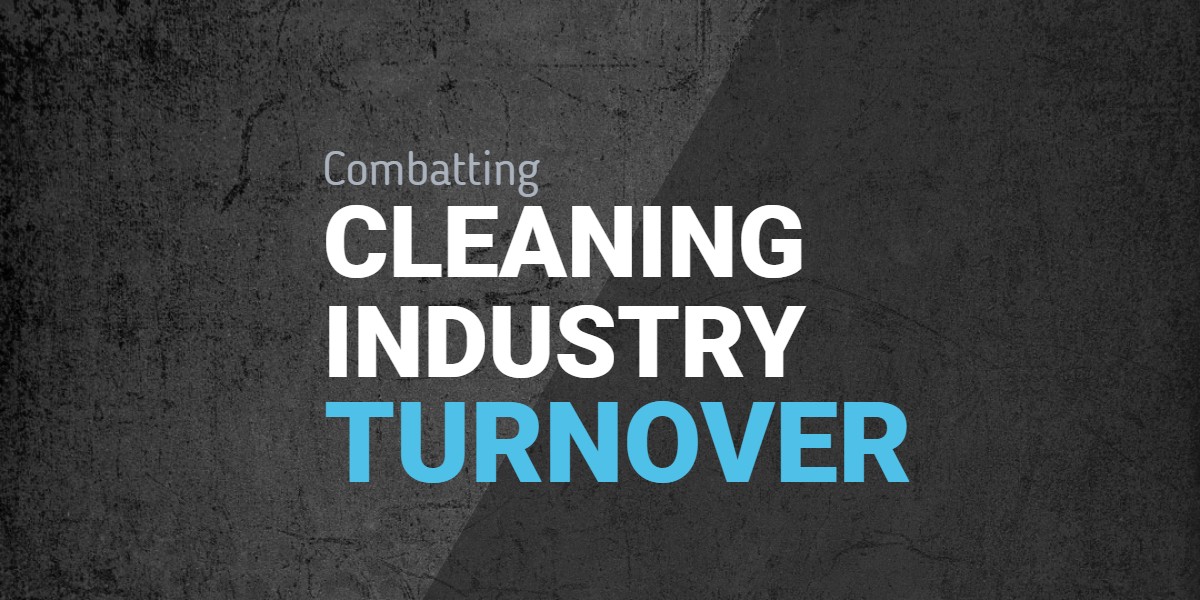The cleaning industry possesses an appallingly high turnover ratio that negatively impacts the health, safety, and performance of offices and office workers alike.

Confronting the Challenge of High Turnover in the Cleaning Services Industry
The turnover rate amongst cleaning industry workers is disturbing, almost comically enormous, with typical estimates averaging between 200% to 400% annually, costing businesses hundreds of thousands of dollars in wasted training and onboarding costs.
[...] turnover in the industry runs anywhere from 75 percent to historical highs of 400 percent.
To understand what these percentages actually mean when it comes to dollars and cents, let’s suppose a contract cleaner has a staff of 100 employees and a turnover rate of 300 percent annually.
That’s 300 new workers every year.
Each time a worker leaves, it costs this contractor $1,000 in recruiting, orientation, and basic training costs to bring in a replacement.
To maintain a staff of 100 workers with a 300 percent turnover means she’ll be hiring 300 workers annually, costing a whopping $300,000.
The reason for this incredibly high discrepancy is even more disturbing than the turnover percentage--poor attitude, a pervasive challenge across all industries.
According to a recent article published by Business.com;
46 percent of new hires will fail within 18 months.
Only 19 percent of new hires will succeed over the long term.
Of those that don’t last, a full 89 percent lose their jobs due to something involving their attitude or personality (lack of coachability, poor emotional intelligence, poor motivation, or a bad temperament.)
Only 11 percent of new hire failures lose their jobs due to technical incompetence.
The Effects of High Turnover in the Cleaning Industry
The impact of the high turnover percentage in the cleaning industry, especially as a direct result of poor attitude--likely leading to poor performance--extends beyond the department to the rest of the organization, as well as the customers it serves.
- Poorly cleaned facilities - In any industry, new and inexperienced workers will rarely be able to keep up with the productive output of an experienced counterpart. This leads to substandard levels of performance and increased costs in the form of management overhead, time to task completion, wasted supplies, and potentially damaged equipment, as well as facility access issues for other employees due to incomplete cleaning tasks or problems with safe entry.
- Facility safety issues - Untrained staff or poorly motivated custodial workers with bad attitudes are less likely to be as thorough in their cleaning assignments, leading to a host of potential safety issues that include surface cross-contamination, substandard infection control procedures, and possible slip and fall accidents.
- Diminished business reputation - The news of high turnover numbers in any business spreads like wildfire and leaves potential customers, as well as prospective employees or investors with an uneasy feeling that can have a direct impact on an organization's bottom line as outside speculation mounts concerning the treatment of employees vs. customers, as well as the leadership, management, and future of the business.
- Increased customer costs - Few organizations can readily afford such a large chunk of their profits being funneled into the endless cycle of hire, train, fire, rehire that appears to be the status quo of the cleaning industry. This means increasing prices to customers for the same product or service, or reducing internal infrastructure investments and other expenses, leading to subpar product and service offerings.
For More Information:
Addressing the Turnover Rate
Addressing the turnover rate for cleaning services can be as simple or challenging as you want to make it.
Internally, you'll need to:
- Establish a recruiting, vetting, and hiring process that identifies candidates with positive attitudes that have the right temperament for the industry.
- Create a substantial competitive salary package that demonstrates a sincere desire on the part of the company to retain staff from other industries or businesses.
- Provide ongoing training in health, safety, procedures, and new equipment to allow the custodial worker to grow within the profession.
- Maintain up to date equipment, as well as modernized digital monitoring and management services to improve the quality of service delivery and job satisfaction for members of the department, and;
- Promote from within to demonstrate real advancement potential within the department.
Alternatively, you can outsource your services to a franchise business owner who is financially vested in the success of their business, as well as being backed by numerous training opportunities through their Master Franchise.
Takeaway
The turnover rate for the cleaning industry is a real problem that has demonstrably been ignored by business managers, owners, and investors for far too long.
The impact of poor attitude and performance on the health and safety of other employees and customers ranges from the dangerous to the potentially deadly.
The financial impact of having to rehire and retrain your entire cleaning staff over and over, three times per year, every year you're in business is ridiculous.
Outsourcing to a franchised janitorial services provider will eliminate the ongoing challenge and cost of the endless cycle of poor attitudes and performance leading to reduced productivity and results.
If you would like to receive more information regarding the benefits of outsourced custodial services for your school or business--contact us today for a free quote!
In Bakersfield CA, call (661) 437-3253
In Fresno CA, call (559) 206-1059
In Valencia CA, or Santa Clarita CA, call (661) 437-3253

